Assessing Halifax's Bicycle Infrastructure Development
VerifiedAdded on 2020/05/11
|21
|3990
|46
AI Summary
The task involves an in-depth review of Halifax's bicycle lanes and trail systems, with an emphasis on their evolution from sparse beginnings to a more interconnected network that supports sustainable transportation. The study will cover different trails such as the Chain of Lakes Trail, Salt Marsh Trail, and the Dartmouth Waterfront, as well as other resources provided by Halifax Regional Municipality (HRM). Through bibliographic references, the assignment aims to understand the impact of these developments on urban planning and active transportation within the city. The analysis will include both primary data collection and secondary research based on existing literature and municipal records.

Running head: PUBLIC ADMINISTRATION
Public Administration
Name of the student
University name
Author’s note
Public Administration
Name of the student
University name
Author’s note
Paraphrase This Document
Need a fresh take? Get an instant paraphrase of this document with our AI Paraphraser
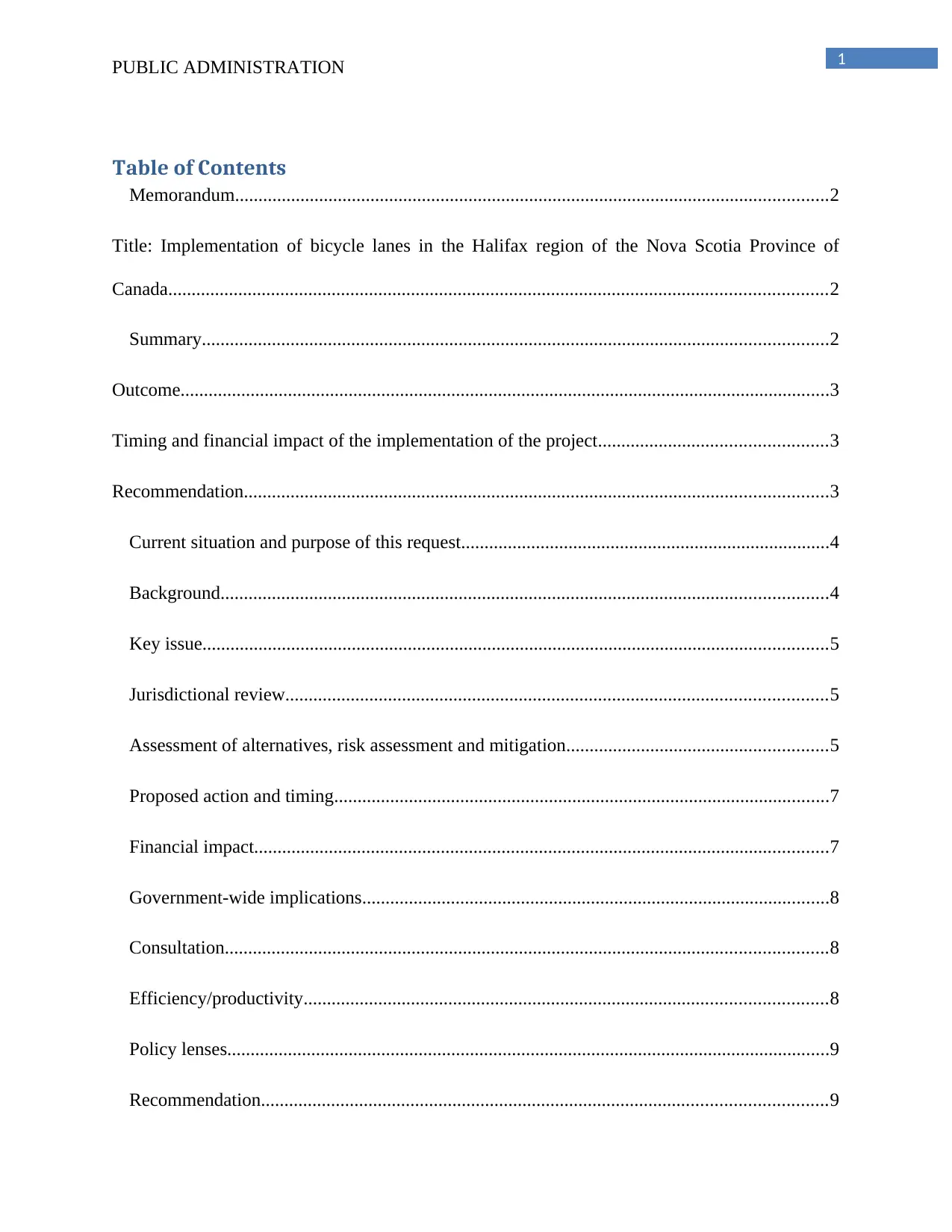
1PUBLIC ADMINISTRATION
Table of Contents
Memorandum...............................................................................................................................2
Title: Implementation of bicycle lanes in the Halifax region of the Nova Scotia Province of
Canada.............................................................................................................................................2
Summary......................................................................................................................................2
Outcome...........................................................................................................................................3
Timing and financial impact of the implementation of the project.................................................3
Recommendation.............................................................................................................................3
Current situation and purpose of this request...............................................................................4
Background..................................................................................................................................4
Key issue......................................................................................................................................5
Jurisdictional review....................................................................................................................5
Assessment of alternatives, risk assessment and mitigation........................................................5
Proposed action and timing..........................................................................................................7
Financial impact...........................................................................................................................7
Government-wide implications....................................................................................................8
Consultation.................................................................................................................................8
Efficiency/productivity................................................................................................................8
Policy lenses.................................................................................................................................9
Recommendation.........................................................................................................................9
Table of Contents
Memorandum...............................................................................................................................2
Title: Implementation of bicycle lanes in the Halifax region of the Nova Scotia Province of
Canada.............................................................................................................................................2
Summary......................................................................................................................................2
Outcome...........................................................................................................................................3
Timing and financial impact of the implementation of the project.................................................3
Recommendation.............................................................................................................................3
Current situation and purpose of this request...............................................................................4
Background..................................................................................................................................4
Key issue......................................................................................................................................5
Jurisdictional review....................................................................................................................5
Assessment of alternatives, risk assessment and mitigation........................................................5
Proposed action and timing..........................................................................................................7
Financial impact...........................................................................................................................7
Government-wide implications....................................................................................................8
Consultation.................................................................................................................................8
Efficiency/productivity................................................................................................................8
Policy lenses.................................................................................................................................9
Recommendation.........................................................................................................................9

2PUBLIC ADMINISTRATION
References..................................................................................................................................11
Bibliography...............................................................................................................................13
Appendix 1.................................................................................................................................16
Appendix 2.................................................................................................................................17
References..................................................................................................................................11
Bibliography...............................................................................................................................13
Appendix 1.................................................................................................................................16
Appendix 2.................................................................................................................................17
You're viewing a preview
Unlock full access by subscribing today!
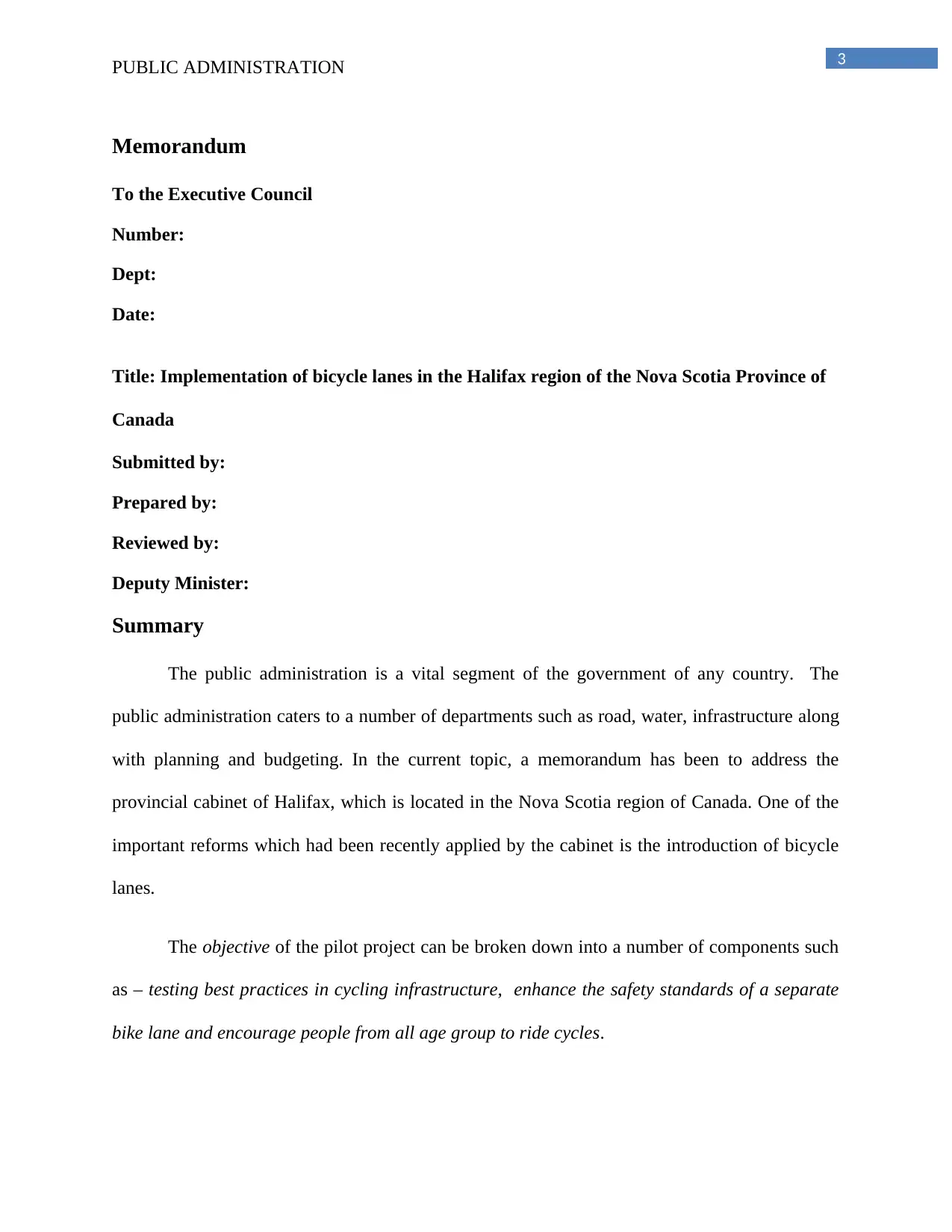
3PUBLIC ADMINISTRATION
Memorandum
To the Executive Council
Number:
Dept:
Date:
Title: Implementation of bicycle lanes in the Halifax region of the Nova Scotia Province of
Canada
Submitted by:
Prepared by:
Reviewed by:
Deputy Minister:
Summary
The public administration is a vital segment of the government of any country. The
public administration caters to a number of departments such as road, water, infrastructure along
with planning and budgeting. In the current topic, a memorandum has been to address the
provincial cabinet of Halifax, which is located in the Nova Scotia region of Canada. One of the
important reforms which had been recently applied by the cabinet is the introduction of bicycle
lanes.
The objective of the pilot project can be broken down into a number of components such
as – testing best practices in cycling infrastructure, enhance the safety standards of a separate
bike lane and encourage people from all age group to ride cycles.
Memorandum
To the Executive Council
Number:
Dept:
Date:
Title: Implementation of bicycle lanes in the Halifax region of the Nova Scotia Province of
Canada
Submitted by:
Prepared by:
Reviewed by:
Deputy Minister:
Summary
The public administration is a vital segment of the government of any country. The
public administration caters to a number of departments such as road, water, infrastructure along
with planning and budgeting. In the current topic, a memorandum has been to address the
provincial cabinet of Halifax, which is located in the Nova Scotia region of Canada. One of the
important reforms which had been recently applied by the cabinet is the introduction of bicycle
lanes.
The objective of the pilot project can be broken down into a number of components such
as – testing best practices in cycling infrastructure, enhance the safety standards of a separate
bike lane and encourage people from all age group to ride cycles.
Paraphrase This Document
Need a fresh take? Get an instant paraphrase of this document with our AI Paraphraser
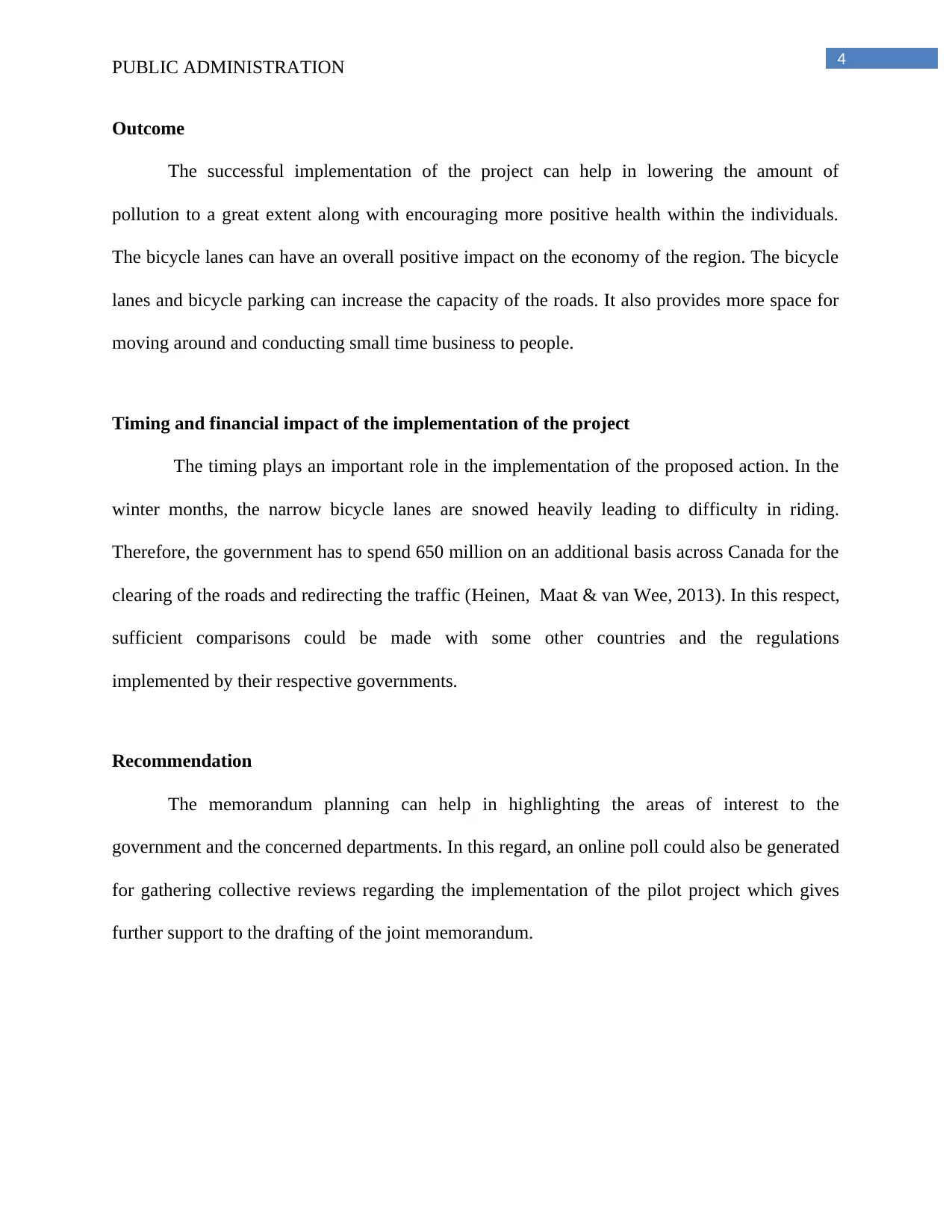
4PUBLIC ADMINISTRATION
Outcome
The successful implementation of the project can help in lowering the amount of
pollution to a great extent along with encouraging more positive health within the individuals.
The bicycle lanes can have an overall positive impact on the economy of the region. The bicycle
lanes and bicycle parking can increase the capacity of the roads. It also provides more space for
moving around and conducting small time business to people.
Timing and financial impact of the implementation of the project
The timing plays an important role in the implementation of the proposed action. In the
winter months, the narrow bicycle lanes are snowed heavily leading to difficulty in riding.
Therefore, the government has to spend 650 million on an additional basis across Canada for the
clearing of the roads and redirecting the traffic (Heinen, Maat & van Wee, 2013). In this respect,
sufficient comparisons could be made with some other countries and the regulations
implemented by their respective governments.
Recommendation
The memorandum planning can help in highlighting the areas of interest to the
government and the concerned departments. In this regard, an online poll could also be generated
for gathering collective reviews regarding the implementation of the pilot project which gives
further support to the drafting of the joint memorandum.
Outcome
The successful implementation of the project can help in lowering the amount of
pollution to a great extent along with encouraging more positive health within the individuals.
The bicycle lanes can have an overall positive impact on the economy of the region. The bicycle
lanes and bicycle parking can increase the capacity of the roads. It also provides more space for
moving around and conducting small time business to people.
Timing and financial impact of the implementation of the project
The timing plays an important role in the implementation of the proposed action. In the
winter months, the narrow bicycle lanes are snowed heavily leading to difficulty in riding.
Therefore, the government has to spend 650 million on an additional basis across Canada for the
clearing of the roads and redirecting the traffic (Heinen, Maat & van Wee, 2013). In this respect,
sufficient comparisons could be made with some other countries and the regulations
implemented by their respective governments.
Recommendation
The memorandum planning can help in highlighting the areas of interest to the
government and the concerned departments. In this regard, an online poll could also be generated
for gathering collective reviews regarding the implementation of the pilot project which gives
further support to the drafting of the joint memorandum.
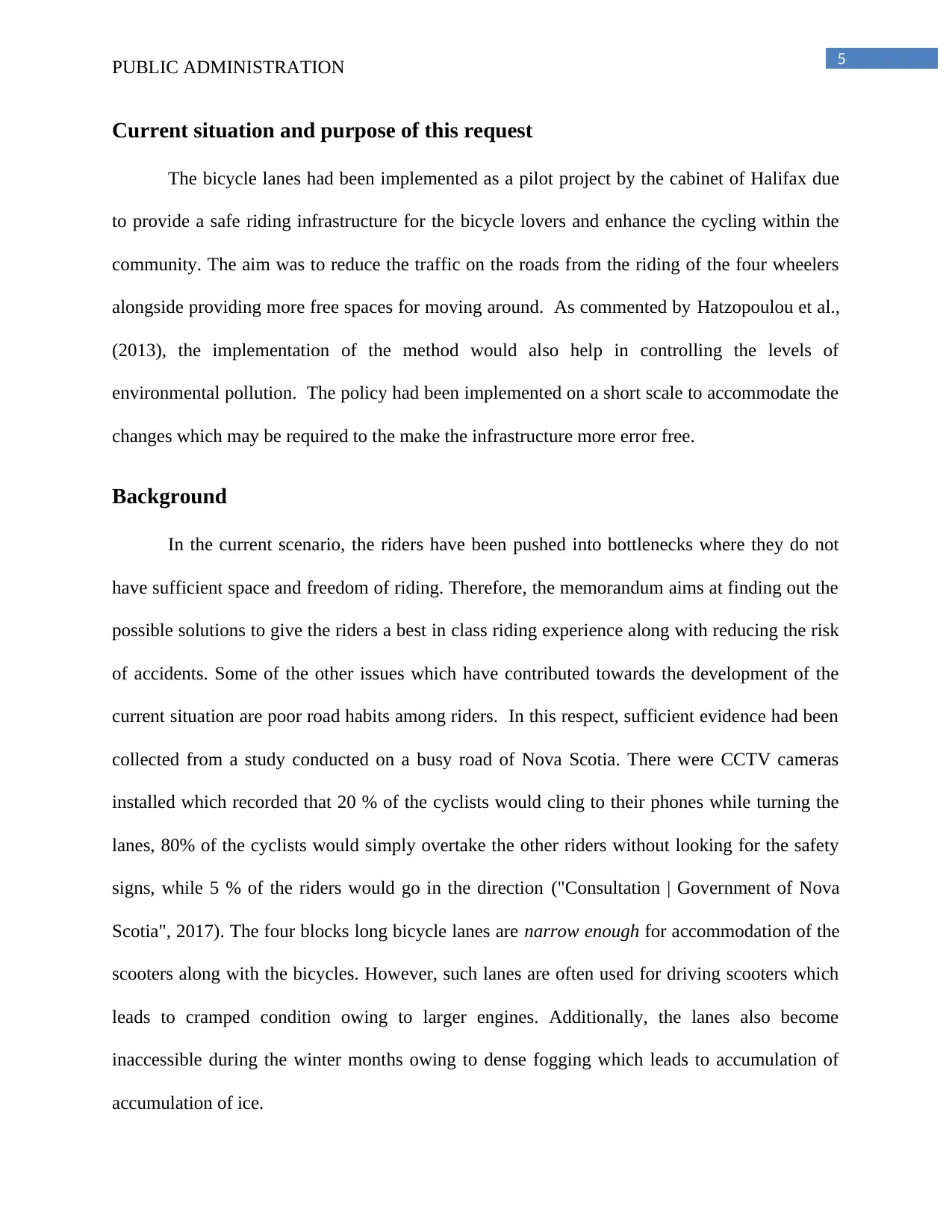
5PUBLIC ADMINISTRATION
Current situation and purpose of this request
The bicycle lanes had been implemented as a pilot project by the cabinet of Halifax due
to provide a safe riding infrastructure for the bicycle lovers and enhance the cycling within the
community. The aim was to reduce the traffic on the roads from the riding of the four wheelers
alongside providing more free spaces for moving around. As commented by Hatzopoulou et al.,
(2013), the implementation of the method would also help in controlling the levels of
environmental pollution. The policy had been implemented on a short scale to accommodate the
changes which may be required to the make the infrastructure more error free.
Background
In the current scenario, the riders have been pushed into bottlenecks where they do not
have sufficient space and freedom of riding. Therefore, the memorandum aims at finding out the
possible solutions to give the riders a best in class riding experience along with reducing the risk
of accidents. Some of the other issues which have contributed towards the development of the
current situation are poor road habits among riders. In this respect, sufficient evidence had been
collected from a study conducted on a busy road of Nova Scotia. There were CCTV cameras
installed which recorded that 20 % of the cyclists would cling to their phones while turning the
lanes, 80% of the cyclists would simply overtake the other riders without looking for the safety
signs, while 5 % of the riders would go in the direction ("Consultation | Government of Nova
Scotia", 2017). The four blocks long bicycle lanes are narrow enough for accommodation of the
scooters along with the bicycles. However, such lanes are often used for driving scooters which
leads to cramped condition owing to larger engines. Additionally, the lanes also become
inaccessible during the winter months owing to dense fogging which leads to accumulation of
accumulation of ice.
Current situation and purpose of this request
The bicycle lanes had been implemented as a pilot project by the cabinet of Halifax due
to provide a safe riding infrastructure for the bicycle lovers and enhance the cycling within the
community. The aim was to reduce the traffic on the roads from the riding of the four wheelers
alongside providing more free spaces for moving around. As commented by Hatzopoulou et al.,
(2013), the implementation of the method would also help in controlling the levels of
environmental pollution. The policy had been implemented on a short scale to accommodate the
changes which may be required to the make the infrastructure more error free.
Background
In the current scenario, the riders have been pushed into bottlenecks where they do not
have sufficient space and freedom of riding. Therefore, the memorandum aims at finding out the
possible solutions to give the riders a best in class riding experience along with reducing the risk
of accidents. Some of the other issues which have contributed towards the development of the
current situation are poor road habits among riders. In this respect, sufficient evidence had been
collected from a study conducted on a busy road of Nova Scotia. There were CCTV cameras
installed which recorded that 20 % of the cyclists would cling to their phones while turning the
lanes, 80% of the cyclists would simply overtake the other riders without looking for the safety
signs, while 5 % of the riders would go in the direction ("Consultation | Government of Nova
Scotia", 2017). The four blocks long bicycle lanes are narrow enough for accommodation of the
scooters along with the bicycles. However, such lanes are often used for driving scooters which
leads to cramped condition owing to larger engines. Additionally, the lanes also become
inaccessible during the winter months owing to dense fogging which leads to accumulation of
accumulation of ice.
You're viewing a preview
Unlock full access by subscribing today!
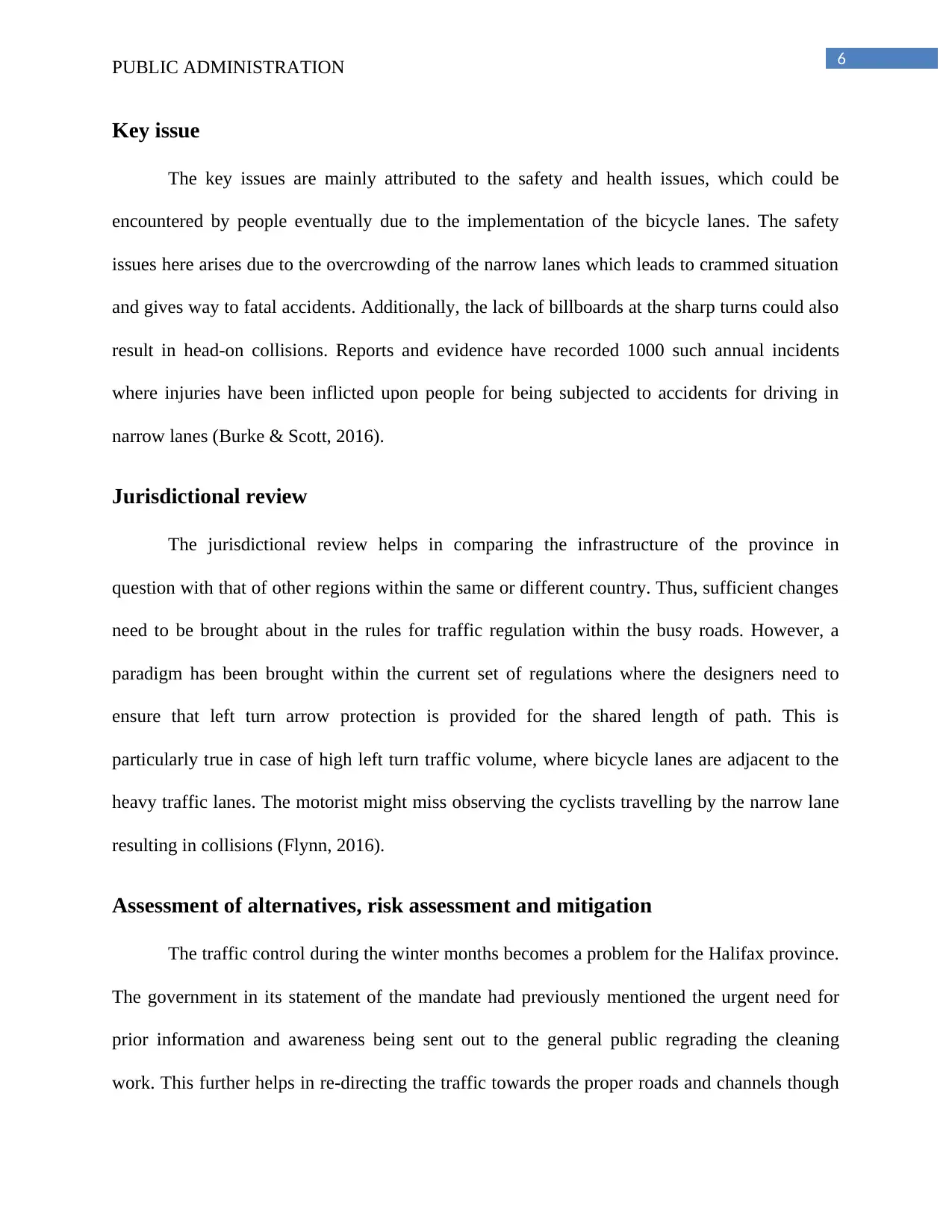
6PUBLIC ADMINISTRATION
Key issue
The key issues are mainly attributed to the safety and health issues, which could be
encountered by people eventually due to the implementation of the bicycle lanes. The safety
issues here arises due to the overcrowding of the narrow lanes which leads to crammed situation
and gives way to fatal accidents. Additionally, the lack of billboards at the sharp turns could also
result in head-on collisions. Reports and evidence have recorded 1000 such annual incidents
where injuries have been inflicted upon people for being subjected to accidents for driving in
narrow lanes (Burke & Scott, 2016).
Jurisdictional review
The jurisdictional review helps in comparing the infrastructure of the province in
question with that of other regions within the same or different country. Thus, sufficient changes
need to be brought about in the rules for traffic regulation within the busy roads. However, a
paradigm has been brought within the current set of regulations where the designers need to
ensure that left turn arrow protection is provided for the shared length of path. This is
particularly true in case of high left turn traffic volume, where bicycle lanes are adjacent to the
heavy traffic lanes. The motorist might miss observing the cyclists travelling by the narrow lane
resulting in collisions (Flynn, 2016).
Assessment of alternatives, risk assessment and mitigation
The traffic control during the winter months becomes a problem for the Halifax province.
The government in its statement of the mandate had previously mentioned the urgent need for
prior information and awareness being sent out to the general public regrading the cleaning
work. This further helps in re-directing the traffic towards the proper roads and channels though
Key issue
The key issues are mainly attributed to the safety and health issues, which could be
encountered by people eventually due to the implementation of the bicycle lanes. The safety
issues here arises due to the overcrowding of the narrow lanes which leads to crammed situation
and gives way to fatal accidents. Additionally, the lack of billboards at the sharp turns could also
result in head-on collisions. Reports and evidence have recorded 1000 such annual incidents
where injuries have been inflicted upon people for being subjected to accidents for driving in
narrow lanes (Burke & Scott, 2016).
Jurisdictional review
The jurisdictional review helps in comparing the infrastructure of the province in
question with that of other regions within the same or different country. Thus, sufficient changes
need to be brought about in the rules for traffic regulation within the busy roads. However, a
paradigm has been brought within the current set of regulations where the designers need to
ensure that left turn arrow protection is provided for the shared length of path. This is
particularly true in case of high left turn traffic volume, where bicycle lanes are adjacent to the
heavy traffic lanes. The motorist might miss observing the cyclists travelling by the narrow lane
resulting in collisions (Flynn, 2016).
Assessment of alternatives, risk assessment and mitigation
The traffic control during the winter months becomes a problem for the Halifax province.
The government in its statement of the mandate had previously mentioned the urgent need for
prior information and awareness being sent out to the general public regrading the cleaning
work. This further helps in re-directing the traffic towards the proper roads and channels though
Paraphrase This Document
Need a fresh take? Get an instant paraphrase of this document with our AI Paraphraser
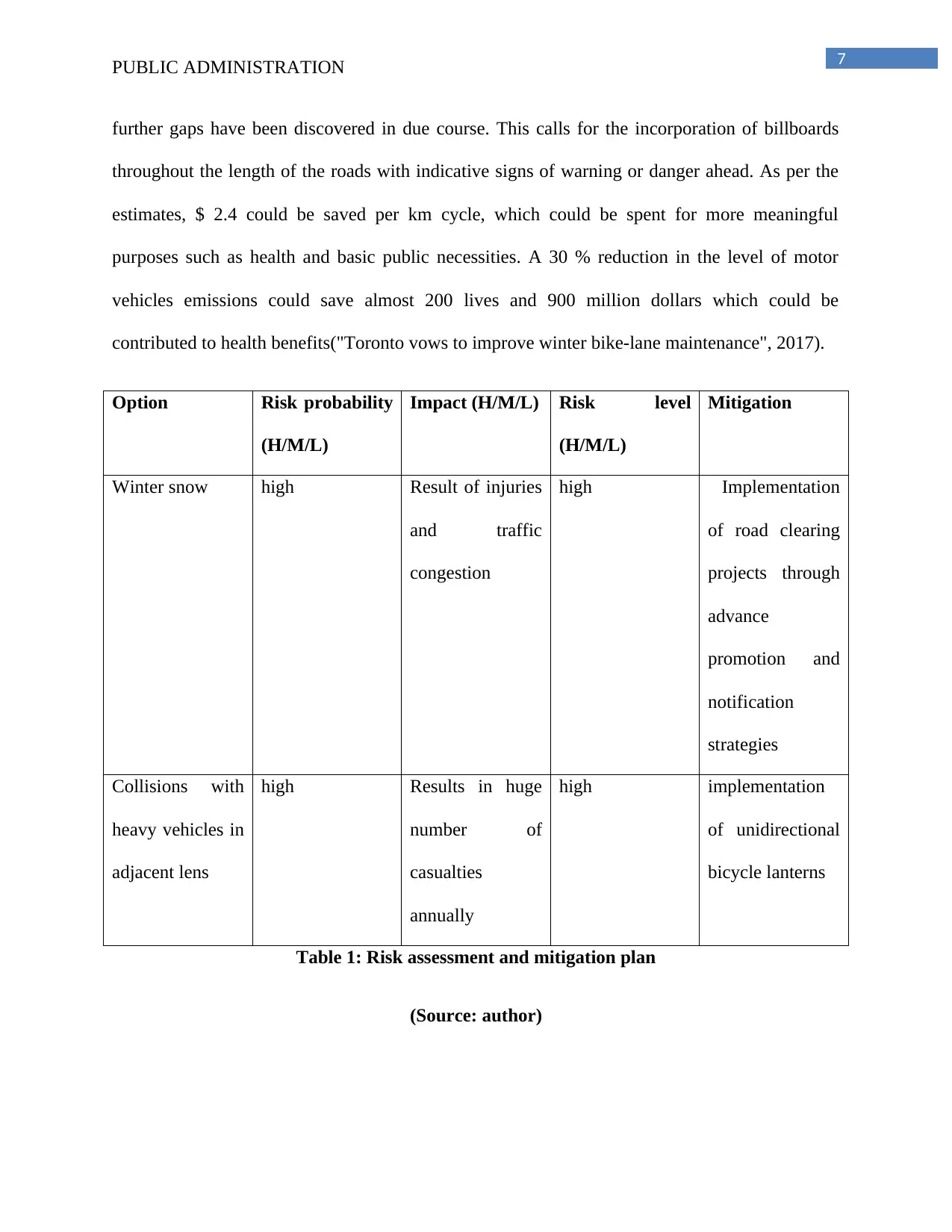
7PUBLIC ADMINISTRATION
further gaps have been discovered in due course. This calls for the incorporation of billboards
throughout the length of the roads with indicative signs of warning or danger ahead. As per the
estimates, $ 2.4 could be saved per km cycle, which could be spent for more meaningful
purposes such as health and basic public necessities. A 30 % reduction in the level of motor
vehicles emissions could save almost 200 lives and 900 million dollars which could be
contributed to health benefits("Toronto vows to improve winter bike-lane maintenance", 2017).
Option Risk probability
(H/M/L)
Impact (H/M/L) Risk level
(H/M/L)
Mitigation
Winter snow high Result of injuries
and traffic
congestion
high Implementation
of road clearing
projects through
advance
promotion and
notification
strategies
Collisions with
heavy vehicles in
adjacent lens
high Results in huge
number of
casualties
annually
high implementation
of unidirectional
bicycle lanterns
Table 1: Risk assessment and mitigation plan
(Source: author)
further gaps have been discovered in due course. This calls for the incorporation of billboards
throughout the length of the roads with indicative signs of warning or danger ahead. As per the
estimates, $ 2.4 could be saved per km cycle, which could be spent for more meaningful
purposes such as health and basic public necessities. A 30 % reduction in the level of motor
vehicles emissions could save almost 200 lives and 900 million dollars which could be
contributed to health benefits("Toronto vows to improve winter bike-lane maintenance", 2017).
Option Risk probability
(H/M/L)
Impact (H/M/L) Risk level
(H/M/L)
Mitigation
Winter snow high Result of injuries
and traffic
congestion
high Implementation
of road clearing
projects through
advance
promotion and
notification
strategies
Collisions with
heavy vehicles in
adjacent lens
high Results in huge
number of
casualties
annually
high implementation
of unidirectional
bicycle lanterns
Table 1: Risk assessment and mitigation plan
(Source: author)
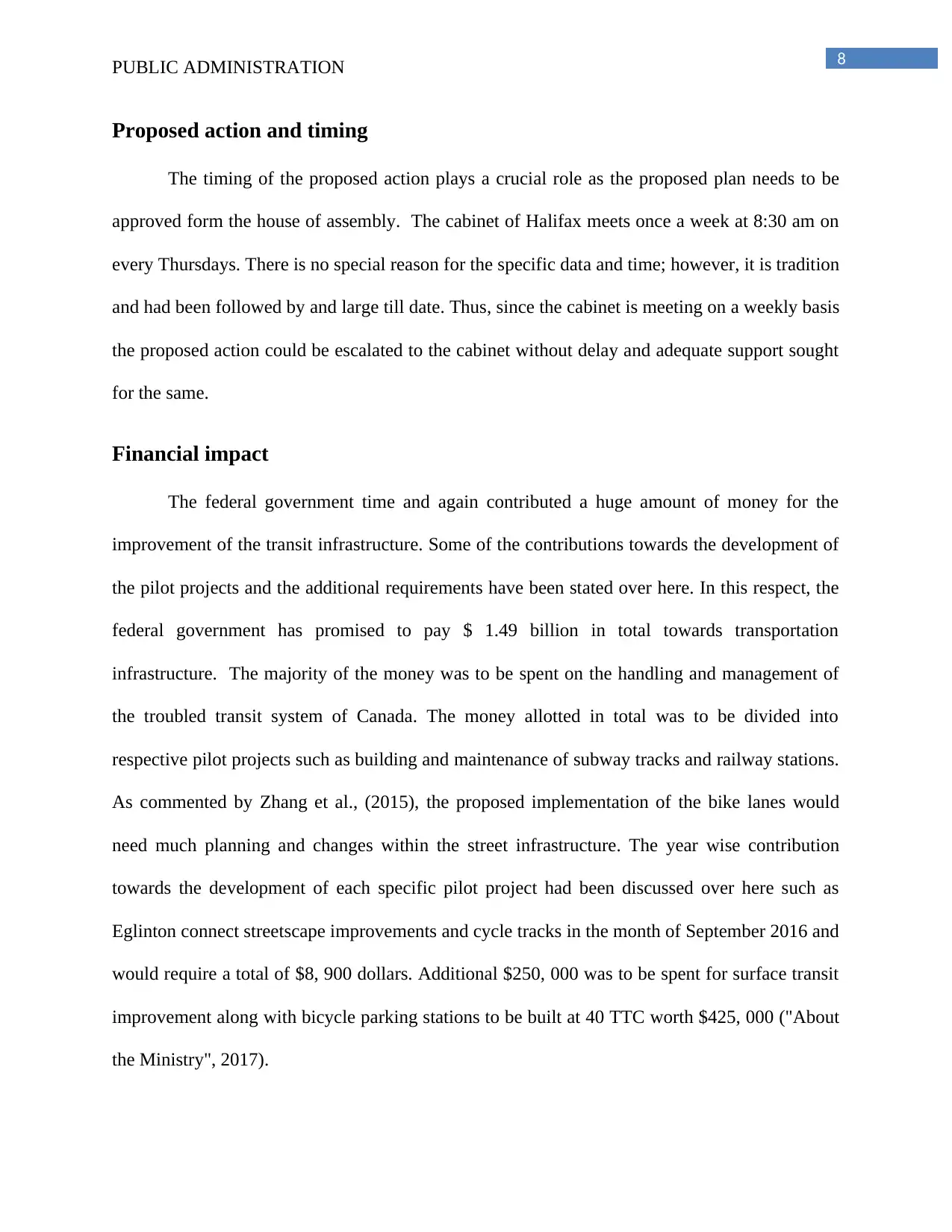
8PUBLIC ADMINISTRATION
Proposed action and timing
The timing of the proposed action plays a crucial role as the proposed plan needs to be
approved form the house of assembly. The cabinet of Halifax meets once a week at 8:30 am on
every Thursdays. There is no special reason for the specific data and time; however, it is tradition
and had been followed by and large till date. Thus, since the cabinet is meeting on a weekly basis
the proposed action could be escalated to the cabinet without delay and adequate support sought
for the same.
Financial impact
The federal government time and again contributed a huge amount of money for the
improvement of the transit infrastructure. Some of the contributions towards the development of
the pilot projects and the additional requirements have been stated over here. In this respect, the
federal government has promised to pay $ 1.49 billion in total towards transportation
infrastructure. The majority of the money was to be spent on the handling and management of
the troubled transit system of Canada. The money allotted in total was to be divided into
respective pilot projects such as building and maintenance of subway tracks and railway stations.
As commented by Zhang et al., (2015), the proposed implementation of the bike lanes would
need much planning and changes within the street infrastructure. The year wise contribution
towards the development of each specific pilot project had been discussed over here such as
Eglinton connect streetscape improvements and cycle tracks in the month of September 2016 and
would require a total of $8, 900 dollars. Additional $250, 000 was to be spent for surface transit
improvement along with bicycle parking stations to be built at 40 TTC worth $425, 000 ("About
the Ministry", 2017).
Proposed action and timing
The timing of the proposed action plays a crucial role as the proposed plan needs to be
approved form the house of assembly. The cabinet of Halifax meets once a week at 8:30 am on
every Thursdays. There is no special reason for the specific data and time; however, it is tradition
and had been followed by and large till date. Thus, since the cabinet is meeting on a weekly basis
the proposed action could be escalated to the cabinet without delay and adequate support sought
for the same.
Financial impact
The federal government time and again contributed a huge amount of money for the
improvement of the transit infrastructure. Some of the contributions towards the development of
the pilot projects and the additional requirements have been stated over here. In this respect, the
federal government has promised to pay $ 1.49 billion in total towards transportation
infrastructure. The majority of the money was to be spent on the handling and management of
the troubled transit system of Canada. The money allotted in total was to be divided into
respective pilot projects such as building and maintenance of subway tracks and railway stations.
As commented by Zhang et al., (2015), the proposed implementation of the bike lanes would
need much planning and changes within the street infrastructure. The year wise contribution
towards the development of each specific pilot project had been discussed over here such as
Eglinton connect streetscape improvements and cycle tracks in the month of September 2016 and
would require a total of $8, 900 dollars. Additional $250, 000 was to be spent for surface transit
improvement along with bicycle parking stations to be built at 40 TTC worth $425, 000 ("About
the Ministry", 2017).
You're viewing a preview
Unlock full access by subscribing today!
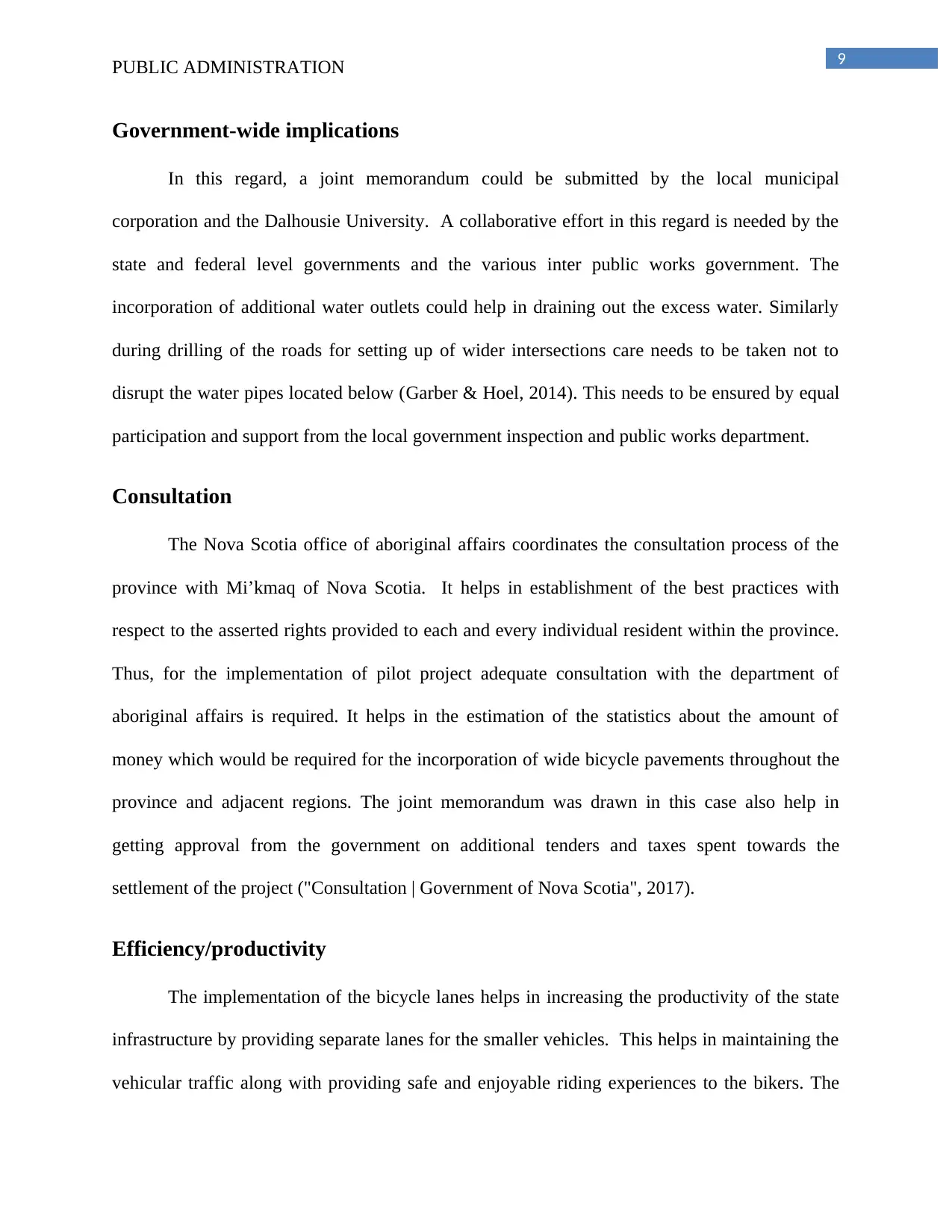
9PUBLIC ADMINISTRATION
Government-wide implications
In this regard, a joint memorandum could be submitted by the local municipal
corporation and the Dalhousie University. A collaborative effort in this regard is needed by the
state and federal level governments and the various inter public works government. The
incorporation of additional water outlets could help in draining out the excess water. Similarly
during drilling of the roads for setting up of wider intersections care needs to be taken not to
disrupt the water pipes located below (Garber & Hoel, 2014). This needs to be ensured by equal
participation and support from the local government inspection and public works department.
Consultation
The Nova Scotia office of aboriginal affairs coordinates the consultation process of the
province with Mi’kmaq of Nova Scotia. It helps in establishment of the best practices with
respect to the asserted rights provided to each and every individual resident within the province.
Thus, for the implementation of pilot project adequate consultation with the department of
aboriginal affairs is required. It helps in the estimation of the statistics about the amount of
money which would be required for the incorporation of wide bicycle pavements throughout the
province and adjacent regions. The joint memorandum was drawn in this case also help in
getting approval from the government on additional tenders and taxes spent towards the
settlement of the project ("Consultation | Government of Nova Scotia", 2017).
Efficiency/productivity
The implementation of the bicycle lanes helps in increasing the productivity of the state
infrastructure by providing separate lanes for the smaller vehicles. This helps in maintaining the
vehicular traffic along with providing safe and enjoyable riding experiences to the bikers. The
Government-wide implications
In this regard, a joint memorandum could be submitted by the local municipal
corporation and the Dalhousie University. A collaborative effort in this regard is needed by the
state and federal level governments and the various inter public works government. The
incorporation of additional water outlets could help in draining out the excess water. Similarly
during drilling of the roads for setting up of wider intersections care needs to be taken not to
disrupt the water pipes located below (Garber & Hoel, 2014). This needs to be ensured by equal
participation and support from the local government inspection and public works department.
Consultation
The Nova Scotia office of aboriginal affairs coordinates the consultation process of the
province with Mi’kmaq of Nova Scotia. It helps in establishment of the best practices with
respect to the asserted rights provided to each and every individual resident within the province.
Thus, for the implementation of pilot project adequate consultation with the department of
aboriginal affairs is required. It helps in the estimation of the statistics about the amount of
money which would be required for the incorporation of wide bicycle pavements throughout the
province and adjacent regions. The joint memorandum was drawn in this case also help in
getting approval from the government on additional tenders and taxes spent towards the
settlement of the project ("Consultation | Government of Nova Scotia", 2017).
Efficiency/productivity
The implementation of the bicycle lanes helps in increasing the productivity of the state
infrastructure by providing separate lanes for the smaller vehicles. This helps in maintaining the
vehicular traffic along with providing safe and enjoyable riding experiences to the bikers. The
Paraphrase This Document
Need a fresh take? Get an instant paraphrase of this document with our AI Paraphraser
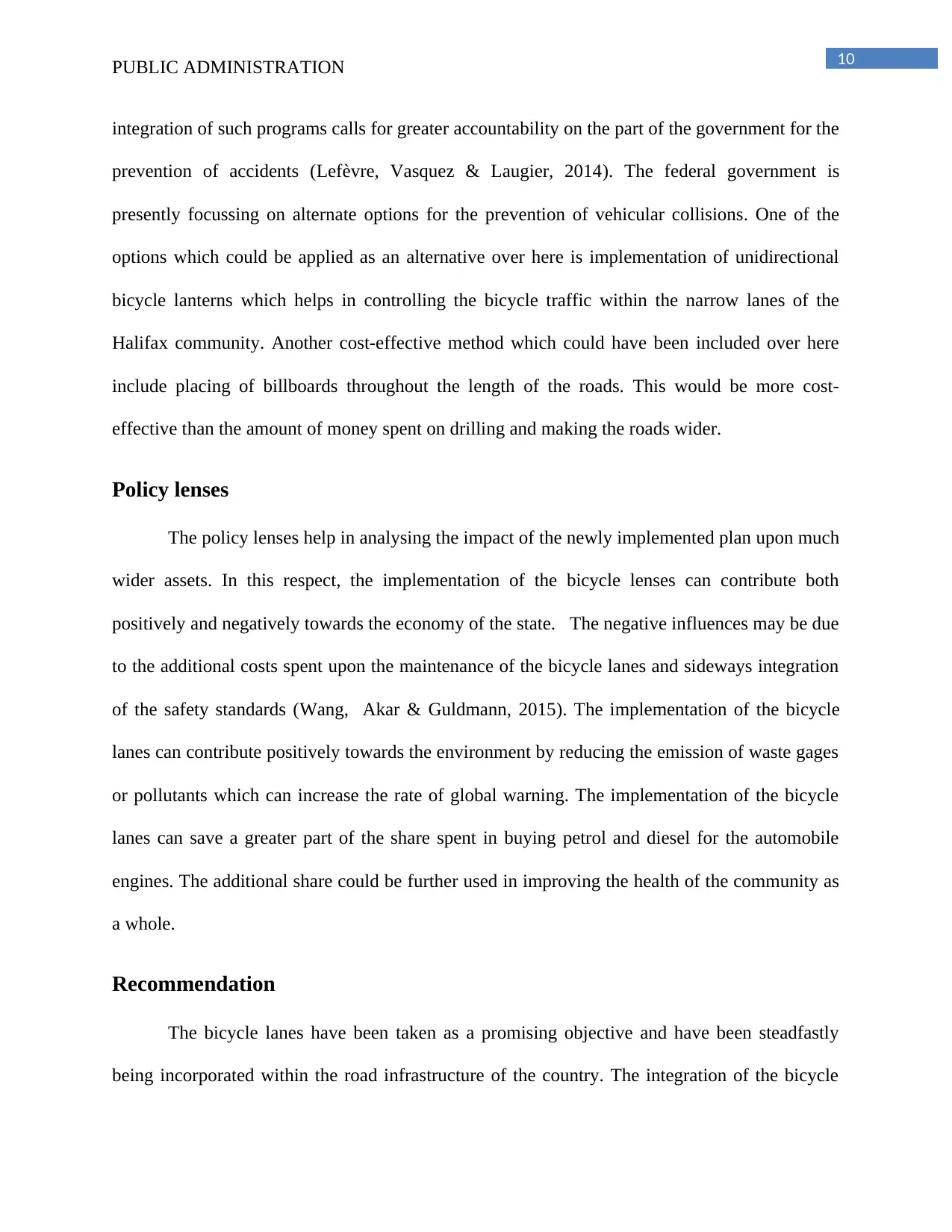
10PUBLIC ADMINISTRATION
integration of such programs calls for greater accountability on the part of the government for the
prevention of accidents (Lefèvre, Vasquez & Laugier, 2014). The federal government is
presently focussing on alternate options for the prevention of vehicular collisions. One of the
options which could be applied as an alternative over here is implementation of unidirectional
bicycle lanterns which helps in controlling the bicycle traffic within the narrow lanes of the
Halifax community. Another cost-effective method which could have been included over here
include placing of billboards throughout the length of the roads. This would be more cost-
effective than the amount of money spent on drilling and making the roads wider.
Policy lenses
The policy lenses help in analysing the impact of the newly implemented plan upon much
wider assets. In this respect, the implementation of the bicycle lenses can contribute both
positively and negatively towards the economy of the state. The negative influences may be due
to the additional costs spent upon the maintenance of the bicycle lanes and sideways integration
of the safety standards (Wang, Akar & Guldmann, 2015). The implementation of the bicycle
lanes can contribute positively towards the environment by reducing the emission of waste gages
or pollutants which can increase the rate of global warning. The implementation of the bicycle
lanes can save a greater part of the share spent in buying petrol and diesel for the automobile
engines. The additional share could be further used in improving the health of the community as
a whole.
Recommendation
The bicycle lanes have been taken as a promising objective and have been steadfastly
being incorporated within the road infrastructure of the country. The integration of the bicycle
integration of such programs calls for greater accountability on the part of the government for the
prevention of accidents (Lefèvre, Vasquez & Laugier, 2014). The federal government is
presently focussing on alternate options for the prevention of vehicular collisions. One of the
options which could be applied as an alternative over here is implementation of unidirectional
bicycle lanterns which helps in controlling the bicycle traffic within the narrow lanes of the
Halifax community. Another cost-effective method which could have been included over here
include placing of billboards throughout the length of the roads. This would be more cost-
effective than the amount of money spent on drilling and making the roads wider.
Policy lenses
The policy lenses help in analysing the impact of the newly implemented plan upon much
wider assets. In this respect, the implementation of the bicycle lenses can contribute both
positively and negatively towards the economy of the state. The negative influences may be due
to the additional costs spent upon the maintenance of the bicycle lanes and sideways integration
of the safety standards (Wang, Akar & Guldmann, 2015). The implementation of the bicycle
lanes can contribute positively towards the environment by reducing the emission of waste gages
or pollutants which can increase the rate of global warning. The implementation of the bicycle
lanes can save a greater part of the share spent in buying petrol and diesel for the automobile
engines. The additional share could be further used in improving the health of the community as
a whole.
Recommendation
The bicycle lanes have been taken as a promising objective and have been steadfastly
being incorporated within the road infrastructure of the country. The integration of the bicycle
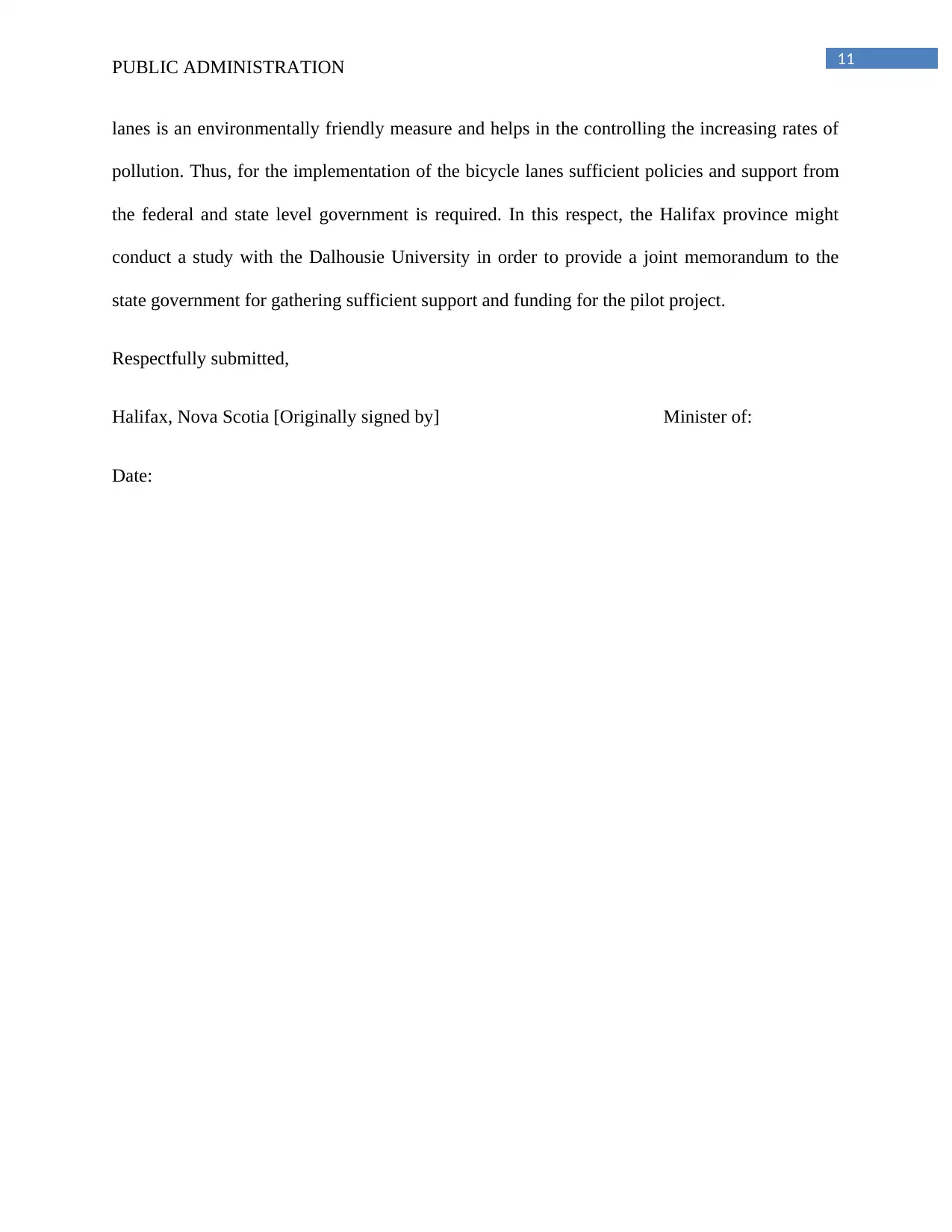
11PUBLIC ADMINISTRATION
lanes is an environmentally friendly measure and helps in the controlling the increasing rates of
pollution. Thus, for the implementation of the bicycle lanes sufficient policies and support from
the federal and state level government is required. In this respect, the Halifax province might
conduct a study with the Dalhousie University in order to provide a joint memorandum to the
state government for gathering sufficient support and funding for the pilot project.
Respectfully submitted,
Halifax, Nova Scotia [Originally signed by] Minister of:
Date:
lanes is an environmentally friendly measure and helps in the controlling the increasing rates of
pollution. Thus, for the implementation of the bicycle lanes sufficient policies and support from
the federal and state level government is required. In this respect, the Halifax province might
conduct a study with the Dalhousie University in order to provide a joint memorandum to the
state government for gathering sufficient support and funding for the pilot project.
Respectfully submitted,
Halifax, Nova Scotia [Originally signed by] Minister of:
Date:
You're viewing a preview
Unlock full access by subscribing today!
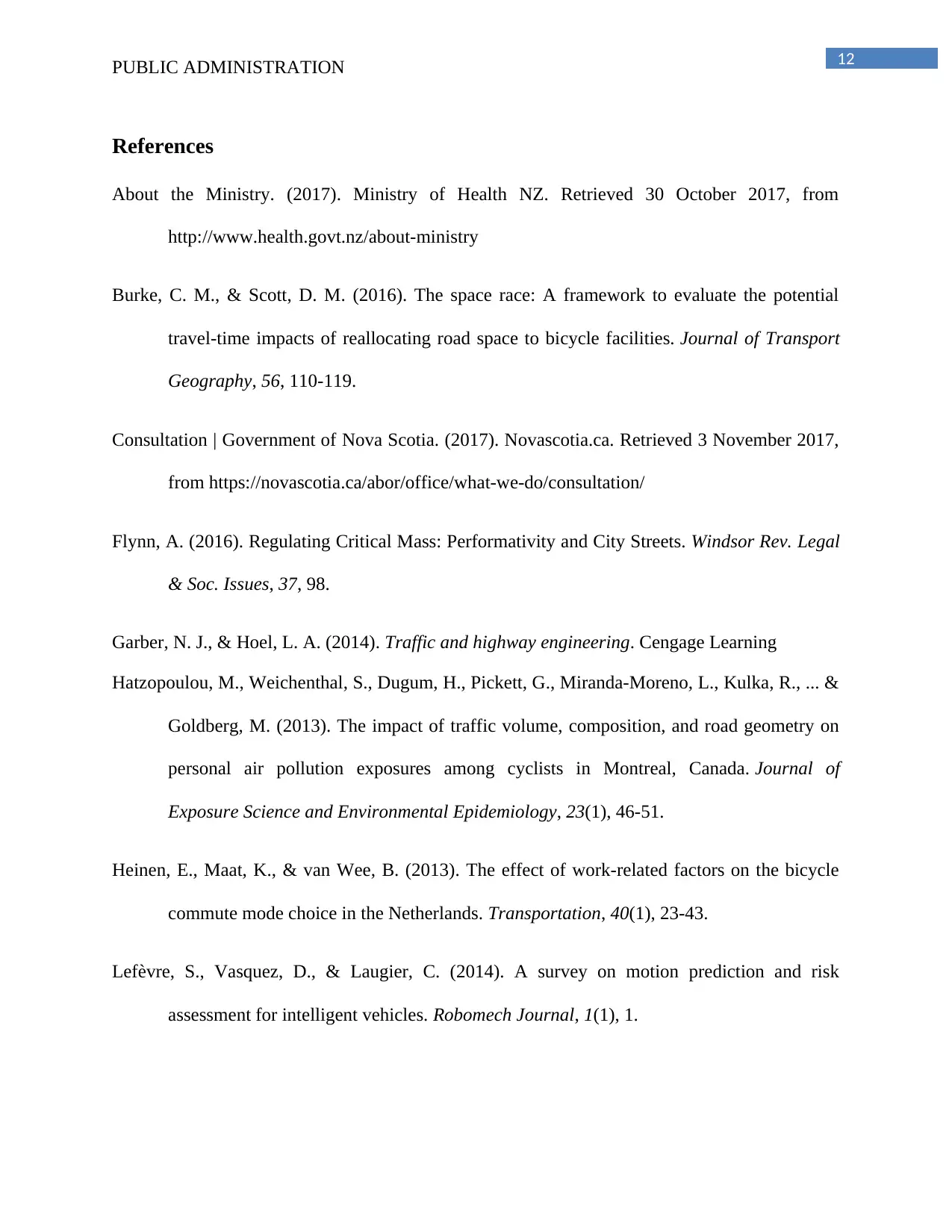
12PUBLIC ADMINISTRATION
References
About the Ministry. (2017). Ministry of Health NZ. Retrieved 30 October 2017, from
http://www.health.govt.nz/about-ministry
Burke, C. M., & Scott, D. M. (2016). The space race: A framework to evaluate the potential
travel-time impacts of reallocating road space to bicycle facilities. Journal of Transport
Geography, 56, 110-119.
Consultation | Government of Nova Scotia. (2017). Novascotia.ca. Retrieved 3 November 2017,
from https://novascotia.ca/abor/office/what-we-do/consultation/
Flynn, A. (2016). Regulating Critical Mass: Performativity and City Streets. Windsor Rev. Legal
& Soc. Issues, 37, 98.
Garber, N. J., & Hoel, L. A. (2014). Traffic and highway engineering. Cengage Learning
Hatzopoulou, M., Weichenthal, S., Dugum, H., Pickett, G., Miranda-Moreno, L., Kulka, R., ... &
Goldberg, M. (2013). The impact of traffic volume, composition, and road geometry on
personal air pollution exposures among cyclists in Montreal, Canada. Journal of
Exposure Science and Environmental Epidemiology, 23(1), 46-51.
Heinen, E., Maat, K., & van Wee, B. (2013). The effect of work-related factors on the bicycle
commute mode choice in the Netherlands. Transportation, 40(1), 23-43.
Lefèvre, S., Vasquez, D., & Laugier, C. (2014). A survey on motion prediction and risk
assessment for intelligent vehicles. Robomech Journal, 1(1), 1.
References
About the Ministry. (2017). Ministry of Health NZ. Retrieved 30 October 2017, from
http://www.health.govt.nz/about-ministry
Burke, C. M., & Scott, D. M. (2016). The space race: A framework to evaluate the potential
travel-time impacts of reallocating road space to bicycle facilities. Journal of Transport
Geography, 56, 110-119.
Consultation | Government of Nova Scotia. (2017). Novascotia.ca. Retrieved 3 November 2017,
from https://novascotia.ca/abor/office/what-we-do/consultation/
Flynn, A. (2016). Regulating Critical Mass: Performativity and City Streets. Windsor Rev. Legal
& Soc. Issues, 37, 98.
Garber, N. J., & Hoel, L. A. (2014). Traffic and highway engineering. Cengage Learning
Hatzopoulou, M., Weichenthal, S., Dugum, H., Pickett, G., Miranda-Moreno, L., Kulka, R., ... &
Goldberg, M. (2013). The impact of traffic volume, composition, and road geometry on
personal air pollution exposures among cyclists in Montreal, Canada. Journal of
Exposure Science and Environmental Epidemiology, 23(1), 46-51.
Heinen, E., Maat, K., & van Wee, B. (2013). The effect of work-related factors on the bicycle
commute mode choice in the Netherlands. Transportation, 40(1), 23-43.
Lefèvre, S., Vasquez, D., & Laugier, C. (2014). A survey on motion prediction and risk
assessment for intelligent vehicles. Robomech Journal, 1(1), 1.
Paraphrase This Document
Need a fresh take? Get an instant paraphrase of this document with our AI Paraphraser

13PUBLIC ADMINISTRATION
Toronto vows to improve winter bike-lane maintenance. (2017). The Globe and Mail. Retrieved
3 November 2017, from https://beta.theglobeandmail.com/news/toronto/toronto-vows-to-
improve-winter-bike-lane-maintenance/article22272785/?ref=http://
www.theglobeandmail.com&
Zhang, L., Zhang, J., Duan, Z. Y., & Bryde, D. (2015). Sustainable bike-sharing systems:
characteristics and commonalities across cases in urban China. Journal of Cleaner
Production, 97, 124-133.
Toronto vows to improve winter bike-lane maintenance. (2017). The Globe and Mail. Retrieved
3 November 2017, from https://beta.theglobeandmail.com/news/toronto/toronto-vows-to-
improve-winter-bike-lane-maintenance/article22272785/?ref=http://
www.theglobeandmail.com&
Zhang, L., Zhang, J., Duan, Z. Y., & Bryde, D. (2015). Sustainable bike-sharing systems:
characteristics and commonalities across cases in urban China. Journal of Cleaner
Production, 97, 124-133.
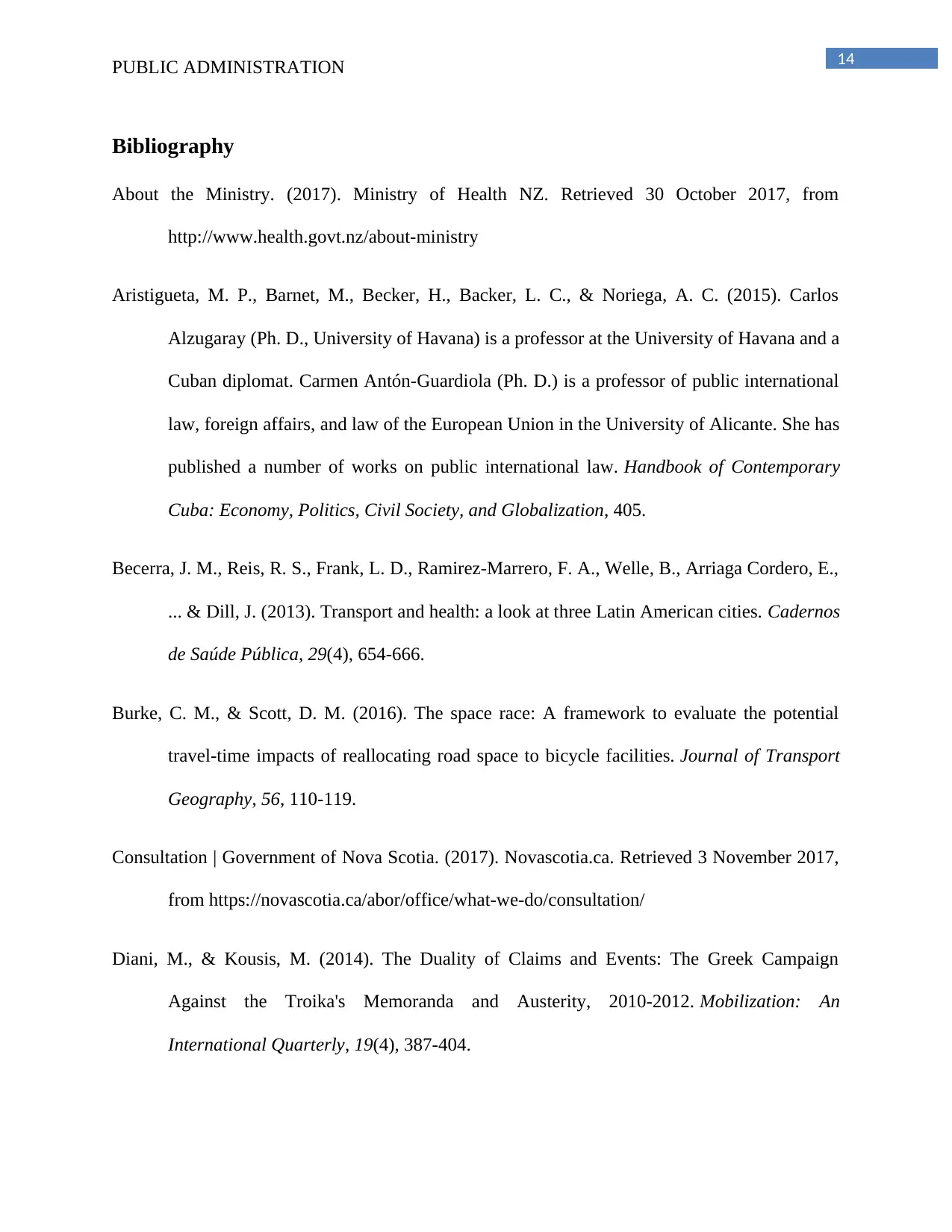
14PUBLIC ADMINISTRATION
Bibliography
About the Ministry. (2017). Ministry of Health NZ. Retrieved 30 October 2017, from
http://www.health.govt.nz/about-ministry
Aristigueta, M. P., Barnet, M., Becker, H., Backer, L. C., & Noriega, A. C. (2015). Carlos
Alzugaray (Ph. D., University of Havana) is a professor at the University of Havana and a
Cuban diplomat. Carmen Antón-Guardiola (Ph. D.) is a professor of public international
law, foreign affairs, and law of the European Union in the University of Alicante. She has
published a number of works on public international law. Handbook of Contemporary
Cuba: Economy, Politics, Civil Society, and Globalization, 405.
Becerra, J. M., Reis, R. S., Frank, L. D., Ramirez-Marrero, F. A., Welle, B., Arriaga Cordero, E.,
... & Dill, J. (2013). Transport and health: a look at three Latin American cities. Cadernos
de Saúde Pública, 29(4), 654-666.
Burke, C. M., & Scott, D. M. (2016). The space race: A framework to evaluate the potential
travel-time impacts of reallocating road space to bicycle facilities. Journal of Transport
Geography, 56, 110-119.
Consultation | Government of Nova Scotia. (2017). Novascotia.ca. Retrieved 3 November 2017,
from https://novascotia.ca/abor/office/what-we-do/consultation/
Diani, M., & Kousis, M. (2014). The Duality of Claims and Events: The Greek Campaign
Against the Troika's Memoranda and Austerity, 2010-2012. Mobilization: An
International Quarterly, 19(4), 387-404.
Bibliography
About the Ministry. (2017). Ministry of Health NZ. Retrieved 30 October 2017, from
http://www.health.govt.nz/about-ministry
Aristigueta, M. P., Barnet, M., Becker, H., Backer, L. C., & Noriega, A. C. (2015). Carlos
Alzugaray (Ph. D., University of Havana) is a professor at the University of Havana and a
Cuban diplomat. Carmen Antón-Guardiola (Ph. D.) is a professor of public international
law, foreign affairs, and law of the European Union in the University of Alicante. She has
published a number of works on public international law. Handbook of Contemporary
Cuba: Economy, Politics, Civil Society, and Globalization, 405.
Becerra, J. M., Reis, R. S., Frank, L. D., Ramirez-Marrero, F. A., Welle, B., Arriaga Cordero, E.,
... & Dill, J. (2013). Transport and health: a look at three Latin American cities. Cadernos
de Saúde Pública, 29(4), 654-666.
Burke, C. M., & Scott, D. M. (2016). The space race: A framework to evaluate the potential
travel-time impacts of reallocating road space to bicycle facilities. Journal of Transport
Geography, 56, 110-119.
Consultation | Government of Nova Scotia. (2017). Novascotia.ca. Retrieved 3 November 2017,
from https://novascotia.ca/abor/office/what-we-do/consultation/
Diani, M., & Kousis, M. (2014). The Duality of Claims and Events: The Greek Campaign
Against the Troika's Memoranda and Austerity, 2010-2012. Mobilization: An
International Quarterly, 19(4), 387-404.
You're viewing a preview
Unlock full access by subscribing today!
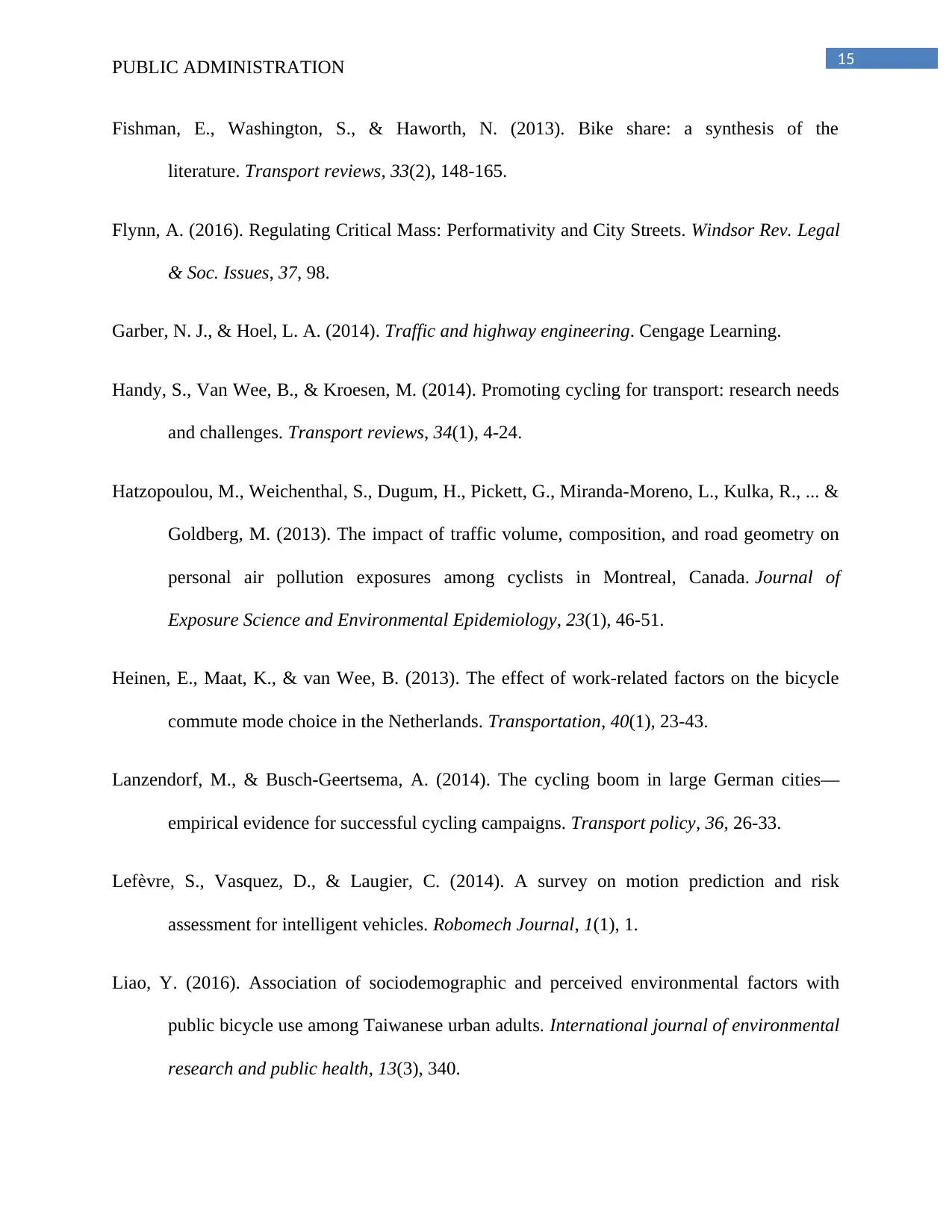
15PUBLIC ADMINISTRATION
Fishman, E., Washington, S., & Haworth, N. (2013). Bike share: a synthesis of the
literature. Transport reviews, 33(2), 148-165.
Flynn, A. (2016). Regulating Critical Mass: Performativity and City Streets. Windsor Rev. Legal
& Soc. Issues, 37, 98.
Garber, N. J., & Hoel, L. A. (2014). Traffic and highway engineering. Cengage Learning.
Handy, S., Van Wee, B., & Kroesen, M. (2014). Promoting cycling for transport: research needs
and challenges. Transport reviews, 34(1), 4-24.
Hatzopoulou, M., Weichenthal, S., Dugum, H., Pickett, G., Miranda-Moreno, L., Kulka, R., ... &
Goldberg, M. (2013). The impact of traffic volume, composition, and road geometry on
personal air pollution exposures among cyclists in Montreal, Canada. Journal of
Exposure Science and Environmental Epidemiology, 23(1), 46-51.
Heinen, E., Maat, K., & van Wee, B. (2013). The effect of work-related factors on the bicycle
commute mode choice in the Netherlands. Transportation, 40(1), 23-43.
Lanzendorf, M., & Busch-Geertsema, A. (2014). The cycling boom in large German cities—
empirical evidence for successful cycling campaigns. Transport policy, 36, 26-33.
Lefèvre, S., Vasquez, D., & Laugier, C. (2014). A survey on motion prediction and risk
assessment for intelligent vehicles. Robomech Journal, 1(1), 1.
Liao, Y. (2016). Association of sociodemographic and perceived environmental factors with
public bicycle use among Taiwanese urban adults. International journal of environmental
research and public health, 13(3), 340.
Fishman, E., Washington, S., & Haworth, N. (2013). Bike share: a synthesis of the
literature. Transport reviews, 33(2), 148-165.
Flynn, A. (2016). Regulating Critical Mass: Performativity and City Streets. Windsor Rev. Legal
& Soc. Issues, 37, 98.
Garber, N. J., & Hoel, L. A. (2014). Traffic and highway engineering. Cengage Learning.
Handy, S., Van Wee, B., & Kroesen, M. (2014). Promoting cycling for transport: research needs
and challenges. Transport reviews, 34(1), 4-24.
Hatzopoulou, M., Weichenthal, S., Dugum, H., Pickett, G., Miranda-Moreno, L., Kulka, R., ... &
Goldberg, M. (2013). The impact of traffic volume, composition, and road geometry on
personal air pollution exposures among cyclists in Montreal, Canada. Journal of
Exposure Science and Environmental Epidemiology, 23(1), 46-51.
Heinen, E., Maat, K., & van Wee, B. (2013). The effect of work-related factors on the bicycle
commute mode choice in the Netherlands. Transportation, 40(1), 23-43.
Lanzendorf, M., & Busch-Geertsema, A. (2014). The cycling boom in large German cities—
empirical evidence for successful cycling campaigns. Transport policy, 36, 26-33.
Lefèvre, S., Vasquez, D., & Laugier, C. (2014). A survey on motion prediction and risk
assessment for intelligent vehicles. Robomech Journal, 1(1), 1.
Liao, Y. (2016). Association of sociodemographic and perceived environmental factors with
public bicycle use among Taiwanese urban adults. International journal of environmental
research and public health, 13(3), 340.
Paraphrase This Document
Need a fresh take? Get an instant paraphrase of this document with our AI Paraphraser
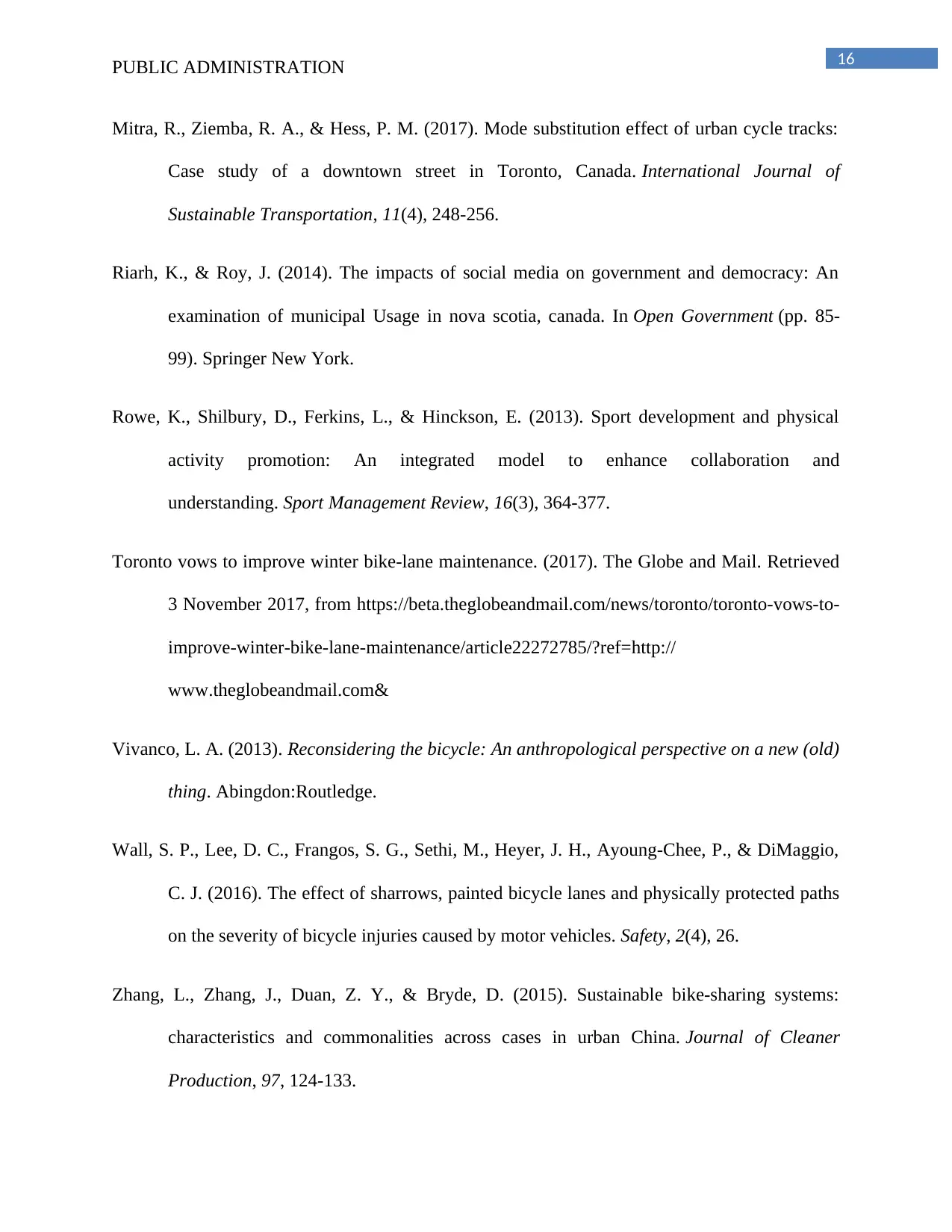
16PUBLIC ADMINISTRATION
Mitra, R., Ziemba, R. A., & Hess, P. M. (2017). Mode substitution effect of urban cycle tracks:
Case study of a downtown street in Toronto, Canada. International Journal of
Sustainable Transportation, 11(4), 248-256.
Riarh, K., & Roy, J. (2014). The impacts of social media on government and democracy: An
examination of municipal Usage in nova scotia, canada. In Open Government (pp. 85-
99). Springer New York.
Rowe, K., Shilbury, D., Ferkins, L., & Hinckson, E. (2013). Sport development and physical
activity promotion: An integrated model to enhance collaboration and
understanding. Sport Management Review, 16(3), 364-377.
Toronto vows to improve winter bike-lane maintenance. (2017). The Globe and Mail. Retrieved
3 November 2017, from https://beta.theglobeandmail.com/news/toronto/toronto-vows-to-
improve-winter-bike-lane-maintenance/article22272785/?ref=http://
www.theglobeandmail.com&
Vivanco, L. A. (2013). Reconsidering the bicycle: An anthropological perspective on a new (old)
thing. Abingdon:Routledge.
Wall, S. P., Lee, D. C., Frangos, S. G., Sethi, M., Heyer, J. H., Ayoung-Chee, P., & DiMaggio,
C. J. (2016). The effect of sharrows, painted bicycle lanes and physically protected paths
on the severity of bicycle injuries caused by motor vehicles. Safety, 2(4), 26.
Zhang, L., Zhang, J., Duan, Z. Y., & Bryde, D. (2015). Sustainable bike-sharing systems:
characteristics and commonalities across cases in urban China. Journal of Cleaner
Production, 97, 124-133.
Mitra, R., Ziemba, R. A., & Hess, P. M. (2017). Mode substitution effect of urban cycle tracks:
Case study of a downtown street in Toronto, Canada. International Journal of
Sustainable Transportation, 11(4), 248-256.
Riarh, K., & Roy, J. (2014). The impacts of social media on government and democracy: An
examination of municipal Usage in nova scotia, canada. In Open Government (pp. 85-
99). Springer New York.
Rowe, K., Shilbury, D., Ferkins, L., & Hinckson, E. (2013). Sport development and physical
activity promotion: An integrated model to enhance collaboration and
understanding. Sport Management Review, 16(3), 364-377.
Toronto vows to improve winter bike-lane maintenance. (2017). The Globe and Mail. Retrieved
3 November 2017, from https://beta.theglobeandmail.com/news/toronto/toronto-vows-to-
improve-winter-bike-lane-maintenance/article22272785/?ref=http://
www.theglobeandmail.com&
Vivanco, L. A. (2013). Reconsidering the bicycle: An anthropological perspective on a new (old)
thing. Abingdon:Routledge.
Wall, S. P., Lee, D. C., Frangos, S. G., Sethi, M., Heyer, J. H., Ayoung-Chee, P., & DiMaggio,
C. J. (2016). The effect of sharrows, painted bicycle lanes and physically protected paths
on the severity of bicycle injuries caused by motor vehicles. Safety, 2(4), 26.
Zhang, L., Zhang, J., Duan, Z. Y., & Bryde, D. (2015). Sustainable bike-sharing systems:
characteristics and commonalities across cases in urban China. Journal of Cleaner
Production, 97, 124-133.

17PUBLIC ADMINISTRATION
Appendix 1
Activity Month 1-2 Month 3-4 Month 5-6 Month 7-8 Month 9-10
Preparation of
memorandum
Collection of
primary data
Collection of
secondary data
Data analysis
Report
preparation
Appendix 1
Activity Month 1-2 Month 3-4 Month 5-6 Month 7-8 Month 9-10
Preparation of
memorandum
Collection of
primary data
Collection of
secondary data
Data analysis
Report
preparation
You're viewing a preview
Unlock full access by subscribing today!

18PUBLIC ADMINISTRATION
Appendix 2
RIDING IN HALIFAX
Cycling Resources
The bicycle lanes and trails on the peninsula of Halifax are choppy and underdeveloped at best.
Bicycle lanes do exist on small portions of South Park Street, Windsor Street, and Brunswick
Street.
Chain of Lakes Trail and BLT Trail
This trail begins on the west side of Joesph Howe Drive and runs along the old Chester Spur Rail
line. The beginning is paved while in the residential area. The Trail quickly becomes a quite
crusher dust trail through the woods as it snakes around lakes on it's way to Bayers Lake
Industrial Park. The trail continues through Bayers Lake and connects to the BLT trail that
utilized the entire old rail line all the way to Yarmouth. This trail passes directly behind the Train
Station Bike and Bean which is a bike shop in Tantallon that is located in an old caboose train
car still sitting on the old tracks this trail replaced.
Salt Marsh Trail
Appendix 2
RIDING IN HALIFAX
Cycling Resources
The bicycle lanes and trails on the peninsula of Halifax are choppy and underdeveloped at best.
Bicycle lanes do exist on small portions of South Park Street, Windsor Street, and Brunswick
Street.
Chain of Lakes Trail and BLT Trail
This trail begins on the west side of Joesph Howe Drive and runs along the old Chester Spur Rail
line. The beginning is paved while in the residential area. The Trail quickly becomes a quite
crusher dust trail through the woods as it snakes around lakes on it's way to Bayers Lake
Industrial Park. The trail continues through Bayers Lake and connects to the BLT trail that
utilized the entire old rail line all the way to Yarmouth. This trail passes directly behind the Train
Station Bike and Bean which is a bike shop in Tantallon that is located in an old caboose train
car still sitting on the old tracks this trail replaced.
Salt Marsh Trail
Paraphrase This Document
Need a fresh take? Get an instant paraphrase of this document with our AI Paraphraser
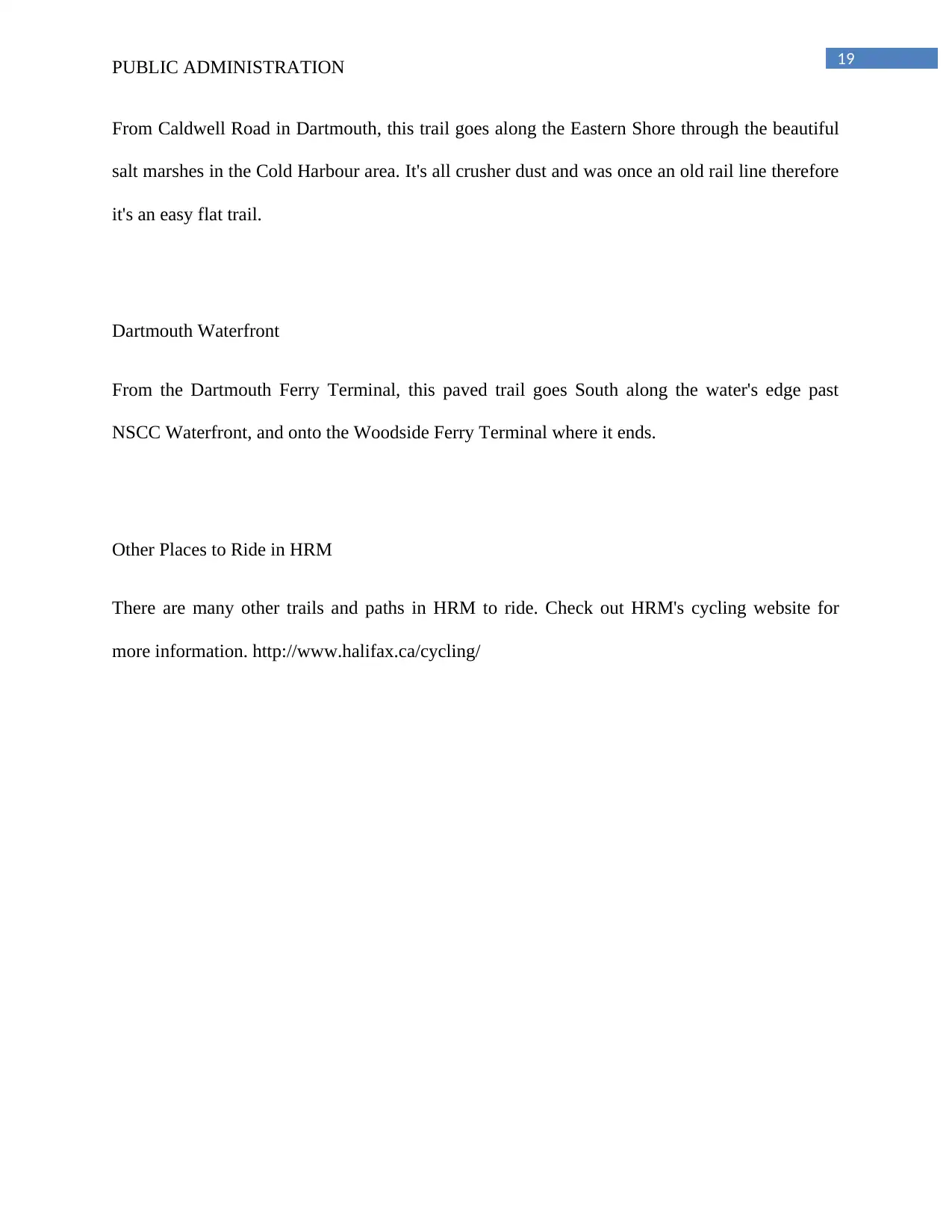
19PUBLIC ADMINISTRATION
From Caldwell Road in Dartmouth, this trail goes along the Eastern Shore through the beautiful
salt marshes in the Cold Harbour area. It's all crusher dust and was once an old rail line therefore
it's an easy flat trail.
Dartmouth Waterfront
From the Dartmouth Ferry Terminal, this paved trail goes South along the water's edge past
NSCC Waterfront, and onto the Woodside Ferry Terminal where it ends.
Other Places to Ride in HRM
There are many other trails and paths in HRM to ride. Check out HRM's cycling website for
more information. http://www.halifax.ca/cycling/
From Caldwell Road in Dartmouth, this trail goes along the Eastern Shore through the beautiful
salt marshes in the Cold Harbour area. It's all crusher dust and was once an old rail line therefore
it's an easy flat trail.
Dartmouth Waterfront
From the Dartmouth Ferry Terminal, this paved trail goes South along the water's edge past
NSCC Waterfront, and onto the Woodside Ferry Terminal where it ends.
Other Places to Ride in HRM
There are many other trails and paths in HRM to ride. Check out HRM's cycling website for
more information. http://www.halifax.ca/cycling/

20PUBLIC ADMINISTRATION
You're viewing a preview
Unlock full access by subscribing today!
1 out of 21
Your All-in-One AI-Powered Toolkit for Academic Success.
+13062052269
info@desklib.com
Available 24*7 on WhatsApp / Email
![[object Object]](/_next/static/media/star-bottom.7253800d.svg)
Unlock your academic potential
© 2024 | Zucol Services PVT LTD | All rights reserved.
